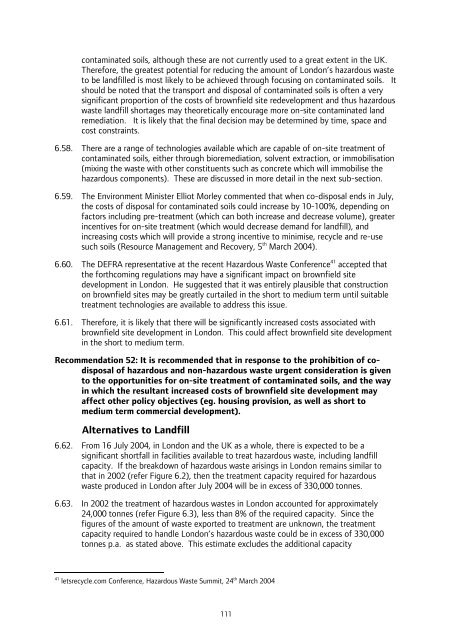London Wider Waste Strategy - London - Greater London Authority
London Wider Waste Strategy - London - Greater London Authority
London Wider Waste Strategy - London - Greater London Authority
Create successful ePaper yourself
Turn your PDF publications into a flip-book with our unique Google optimized e-Paper software.
contaminated soils, although these are not currently used to a great extent in the UK.<br />
Therefore, the greatest potential for reducing the amount of <strong>London</strong>’s hazardous waste<br />
to be landfilled is most likely to be achieved through focusing on contaminated soils. It<br />
should be noted that the transport and disposal of contaminated soils is often a very<br />
significant proportion of the costs of brownfield site redevelopment and thus hazardous<br />
waste landfill shortages may theoretically encourage more on-site contaminated land<br />
remediation. It is likely that the final decision may be determined by time, space and<br />
cost constraints.<br />
6.58. There are a range of technologies available which are capable of on-site treatment of<br />
contaminated soils, either through bioremediation, solvent extraction, or immobilisation<br />
(mixing the waste with other constituents such as concrete which will immobilise the<br />
hazardous components). These are discussed in more detail in the next sub-section.<br />
6.59. The Environment Minister Elliot Morley commented that when co-disposal ends in July,<br />
the costs of disposal for contaminated soils could increase by 10-100%, depending on<br />
factors including pre-treatment (which can both increase and decrease volume), greater<br />
incentives for on-site treatment (which would decrease demand for landfill), and<br />
increasing costs which will provide a strong incentive to minimise, recycle and re-use<br />
such soils (Resource Management and Recovery, 5 th March 2004).<br />
6.60. The DEFRA representative at the recent Hazardous <strong>Waste</strong> Conference 41 accepted that<br />
the forthcoming regulations may have a significant impact on brownfield site<br />
development in <strong>London</strong>. He suggested that it was entirely plausible that construction<br />
on brownfield sites may be greatly curtailed in the short to medium term until suitable<br />
treatment technologies are available to address this issue.<br />
6.61. Therefore, it is likely that there will be significantly increased costs associated with<br />
brownfield site development in <strong>London</strong>. This could affect brownfield site development<br />
in the short to medium term.<br />
Recommendation 52: It is recommended that in response to the prohibition of codisposal<br />
of hazardous and non-hazardous waste urgent consideration is given<br />
to the opportunities for on-site treatment of contaminated soils, and the way<br />
in which the resultant increased costs of brownfield site development may<br />
affect other policy objectives (eg. housing provision, as well as short to<br />
medium term commercial development).<br />
Alternatives to Landfill<br />
6.62. From 16 July 2004, in <strong>London</strong> and the UK as a whole, there is expected to be a<br />
significant shortfall in facilities available to treat hazardous waste, including landfill<br />
capacity. If the breakdown of hazardous waste arisings in <strong>London</strong> remains similar to<br />
that in 2002 (refer Figure 6.2), then the treatment capacity required for hazardous<br />
waste produced in <strong>London</strong> after July 2004 will be in excess of 330,000 tonnes.<br />
6.63. In 2002 the treatment of hazardous wastes in <strong>London</strong> accounted for approximately<br />
24,000 tonnes (refer Figure 6.3), less than 8% of the required capacity. Since the<br />
figures of the amount of waste exported to treatment are unknown, the treatment<br />
capacity required to handle <strong>London</strong>’s hazardous waste could be in excess of 330,000<br />
tonnes p.a. as stated above. This estimate excludes the additional capacity<br />
41 letsrecycle.com Conference, Hazardous <strong>Waste</strong> Summit, 24 th March 2004<br />
111
















